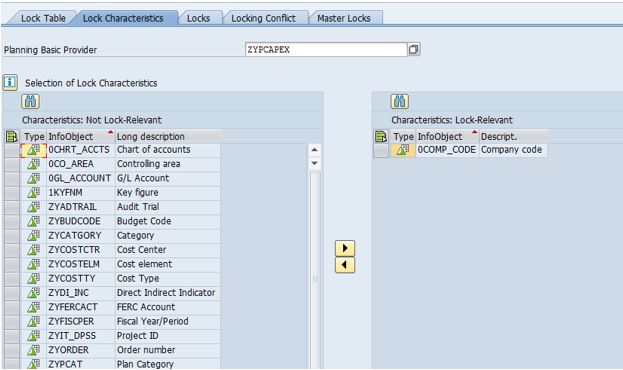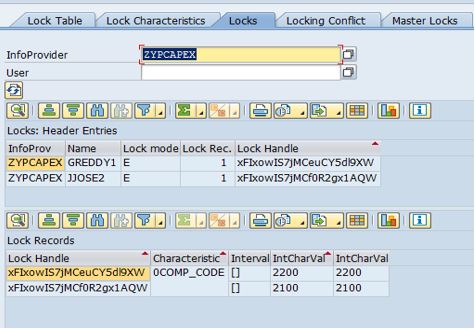
- SAP Community
- Products and Technology
- Financial Management
- Financial Management Blogs by Members
- Locking Functionality in BPC Embedded 10.1
- Subscribe to RSS Feed
- Mark as New
- Mark as Read
- Bookmark
- Subscribe
- Printer Friendly Page
- Report Inappropriate Content
SAP BPC EMBEDDED 10.1: LOCK Functionality
Learn how the locking function is configured and what determines the optimum combination. Understand the basic types of locking and the locking that is used in Embedded 10.1 version.
Key Concept:
Both BPC and IP uses RSPLSE to locking mechanism.
In BPC Standard locking function works on a Stateless server state and BPC Embedded works on the Stateful. In the stateless server, only save on DB changed records are locked, only for the saving time period. And any data saved last will be overwritten. In stateful server the locked data region is based on the filter and BW query definition. In this case the data can only be changed by one user at a time for the specified data region.
Locking Issue and the related T Codes:
The locking function can be rightly viewed in the “RSPLSE” T code. Usually when we do not use the filters in the query the whole of the data set in the cube is set as specified data region and is locked. Thus we will get the below message when the second user tries to open any input schedule built on the respective cube.

If we need to delete the lock then we can achieve it from the T-Code SM12. In SAP lock management (transaction SM12), you use table RSPLS_S_LOCK to display the compressed lock records. To find the actual locked selections, you need to call transaction RSPLSE
In order to avoid locking we need to do the following setting in the T Code RSPLSE
RSPLSE has got five tabs as follows
- Lock Table: Here you specify where the lock table is stored
- Lock Characteristics: Here you specify which characteristics are relevant for lock checks
- Lock: Here, you display locks for a specific InfoProvider and user
- Lock Conflict: The system displays information about the last lock conflict
- Master Locks: You can display and delete master locks here
Locking Conflict
Assume user U1 has acquired an exclusive lock for data region F1 (filter). A user U2 working on overlapping data regions F2 protected by exclusive locks (data in change mode) will get a lock conflict. So the first user U1 acquires the resource and can change/create data in the date region defined by the filter F1. The second user U2 cannot change data for all filters F overlapping with filter F1: a query will be switched to display mode, a planning function will send an error message.
The above statement can be well understood with the below example.
EXAMPLE 1: We have created two queries
- 1) ZALCAP004_TESTLOCKING2 – Where the company code 2100 is hard coded for the filter
- 2) ZALCAP004_TESTLOCKING – Where the company code 2200 is hard coded for the filter


When different users execute the same query and when the lock characters are not configured the screen locks and when we check the locking conflict tab we can see as below.

Now we will set the lock characteristics. We will set company code as lock relevant as below

Now we can see when the reports are executed the locking does not happen and we can also observe that the relevant locks are placed for the respective users

In continuation to the above selection of company code as lock relevant, we have selected four more characteristics (i.e. fiscal year, version, cost center and cost element) If a number of users are performing planning for the same year and the same cost elements, the Cost Center and Version characteristics are sufficient to ensure that different users selection do not overlap.
Navigation attributes as lock characteristics
In expert mode, you can also maintain navigation attributes as lock characteristics. However, navigation attributes are not relevant for locks in the default setting. They are always locked completely. The reason for this is that attribute values may change in a planning session. Otherwise, different users could edit the same objects.
Example:
User 1 plans product P1 that is in product group (navigation attribute) PG1. PG1 is selected in the selection table and there is no restriction on the product. If the lock occurs using the product group, the following may happen: User 2 plans product group PG2. First, user accesses the program and the data is locked. User 2 changes the attribute of product P1 from PG1 to PG2. He saves the data and accesses planning. Since PG2 and PG1 are now formally disjunct, a lock conflict occurs. Both users can edit the same data.
Therefore, if you want to use navigation attributes as lock characteristics, you must ensure from an organizational point of view that these cannot be changed during planning. This applies to manual changes or changes that are caused by Warehouse Management processes.
Further in conclusion the size on the lock server is restricted and it is recommended to keep the lock table smaller to increase the response time of the lock server. As the size of the lock table is dependent on the lock relevant characteristics it is recommended to keep the lock relevant characteristics to its minimum.
Related Notes:
Above are the few important points to be kept in mind. For further information please refer to the note number :0000928044
Authors
GNANEESH REDDY
Gnaneesh Reddy, a Senior Business Consultant at PwC SDC – India. He is qualified chartered accountant, certified BPC 10 & holds a diploma in IFRS professional with experience in diverse roles in Accounting and SAP BPC. Further he has hands on experience in Auditing & Accounting including Auditing, Finalization of Accounts, Investigations & Income Tax Consulting. He has an overall experience of 6 years in the IT industry spanning design, development, testing and support of system/business applications on client/server and multi-tiered architecture models using SAP BPC technology.
SATYA TEJA MOVVA
Satya Teja Movva, a Senior Software Engineer with PricewaterhouseCoopers SDC - India is a SAP professional in BI. He holds a Bachelors degree in Engineering and has five years and five months of experience in SAP Business Intelligence Warehousing. He has experience of working on different versions of SAP BO XIR3, SAP BI 4.0, SP 4.1. As a SAP BO consultant he has executed five projects that include end-to-end implementation, enhancement and support projects. He has good work experience in ETL and expertise in BO Web Intelligence, and SAP Lumira. He has implemented reporting on SAP Bex queries, SAP HANA calculation views and other relational sources.
VIPIN JAIN
Vipin Jain, a Senior Business Consultant at PwC SDC – India. He is qualified chartered accountant with Dimpoma in Information Systems Audit and certifications in SAP HANA 100, BPC 10.0 and PMP. He has more than 13 years of experience in Global Consolidation, Planning, Business Analysis and Project Execution. He has comprehensive knowledge of key business processes underlying complex planning scenarios, IAS, IFRS, US GAAPs. He has an overall experience of 9 years in the IT industry spanning design, configuration, development, enhancements, roll outs, testing and support of business applications on multi-tiered architecture models using SAP Technology.
- SAP Managed Tags:
- SAP Business Planning and Consolidation, version for SAP NetWeaver
You must be a registered user to add a comment. If you've already registered, sign in. Otherwise, register and sign in.
-
Assign Missing Authorization Objects
1 -
Bank Reconciliation Accounts
1 -
CLM
1 -
FIN-CS
1 -
Finance
2 -
GRIR
1 -
Group Reporting
1 -
Invoice Printing Lock
2 -
Mapping of Catalog & Group
1 -
Mapping with User Profile
1 -
matching concept and accounting treatment
1 -
Oil & Gas
1 -
Payment Batch Configurations
1 -
Public Cloud
1 -
Revenue Recognition
1 -
review booklet
1 -
SAP BRIM
1 -
SAP CI
1 -
SAP RAR
1 -
SAP S4HANA Cloud
1 -
SAP S4HANA Cloud for Finance
1 -
SAP Treasury Hedge Accounting
1 -
Z Catalog
1 -
Z Group
1
- Navigate Your Way to SAP PaPM Cloud Universal Model in Financial Management Blogs by SAP
- Unveiling the new functionality in 2024 of SAP PAPM Cloud: Welcome to Universal Model! in Financial Management Blogs by SAP
- CLM in SAP S/4HANA Public Cloud in Financial Management Blogs by Members
- TAC: Quote-to-Cash conference in Budapest in Financial Management Blogs by SAP
- Building a New No-Code App for SAP TRM/PSCD with SAP Build Apps - Part 1 in Financial Management Blogs by SAP